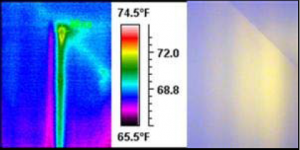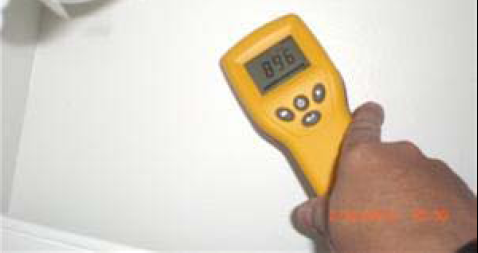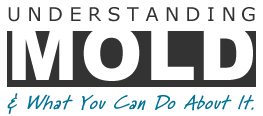To know what you are dealing with, you will likely want to do testing to see what mold species are present and how much. Unfortunately, there are no standard guidelines as to what is considered acceptable. When you have a professional come in, they often take test samples outside and then compare with the inside. Often, they are only alarmed when the indoor counts exceed the outside counts. However, if mold is airborne and you are sick or symptomatic, then there is a problem.
DIY Testing
The number of known mold problems has increased, especially with devastating storms like Katrina and Sandy. In response to that growing need, companies have developed more options for do-it-yourself testing than we had even 4 years ago. Here are some of the options:
| Petri Dish Test | $8/test (Optional $40 lab) |
Mold petri dish/plate test kits check for airborne mold. You start by opening the petri dish in the room for one hour, then close up and put some place warm for 24 hours. This test comes with a sterile swab so you can use the test to analyze visual mold and growth. I’ve personally used a petri dish to test a place I was staying that had a little surface mold near a ceiling fan. It came out very clean so I know these don’t always come up with mold like some reviewers claim.Pro-Lab MO109 Professional Mold Test Kit is $8 at Amazon. It optionally costs an additional $40 if you want to send it in for detailed lab analysis. See instructions for ways you can use the test. |
| 5-Minute Home Mold Test | $54 | This is a DIY test kit that checks for Aspergillus, Penicillium and Stachybotrys mold types. These work very much like pregnancy tests do…they just give you a rapid yes/no answer. Order separate kits for each area to localize your mold problem. A postage-paid mailer and sterile swabs are included for optional lab confirmation.The 5-Minute Home Mold Test runs about $54 from Amazon |
| Indoor Air Quality (IAQ) Mold Screening Check (MSC) Kit | $67 | This tape sampling test scans for 100’s of types of Molds. Return samples in a pre-paid envelope and you get results via email in 1-2 weeks. Online reviews say that support provided by EDLab personnel is outstanding.The Indoor Air Quality (IAQ) Mold Screening Check (MSC) Kit runs about $67 and you can order one at Amazon Marketplace. |
| Air Sample Test | $55, plus $35 lab |
There are now DIY air sampling kits available. We haven’t personally used this ourselves, but the reviews look promising. My Mold Detective’s Mold Test Kit utilizes spore trap air cassettes to sample for mold in your breathable air. They say it is the same technology used in schools, hospitals, elderly living facilities and nurseries; and consumer test results are identical to what Indoor Air Quality (IAQ) Professionals receive when testing in homes, hospitals and schools. This kit also includes 1 tape Lift sample that can be used for testing mold suspected surfaces (identify what is growing on walls, ceilings, vents, furniture or personal property). Reviews say that customer support is excellent and they were good about explaining results.My Mold Detective’s Mold Test Kit for 1 room runs about $55 and you can order one at HomeDepot.com or Amazon Marketplace. Sample processing runs an additional $35 per sample for standard processing, $50 per sample for expedited.More information at www.mymolddetective.com |
| EMSL ERMI Test | $165-$280 | The ERMI is a carpet sampling test that analyzes 36 mold species, using advanced DNA testing, and compares your results obtained in the EPA database generated during the 2006 Housing and Urban Development (HUD) American Healthy Homes Study. The results of your home are compared against the EPA database of moldy and healthy homes. The ERMI is a good screening test to determine whether your home may have a mold problem. This ERMI test gives you a nozzle that you attach to the end of your vacuum. You can then take samples from up to 4 places in the house. View a Sample Results ReportThe price is more expensive the faster you need the results back: 1-Day TAT ($280) / 2-Day TAT ($240) / 5-Day TAT ($165) |
Do you need to call a professional?
Calling a mold inspector or environmental hygienist can provide you with professional testing, recommendations and a remediation plan. They can help you make sense of your problem, help you figure out the full scope of the issue and guide you on how serious it is. They will usually provide you with remediation plan that the remediator will use to plan your remediation and give you a cost estimate.
Mold Inspector vs Environmental Hygienist
For most people, a good mold inspector is all you will need. If your situation involves any type of litigation, you will probably need a good environmental hygienist. The price difference is substantial, so if can use a mold inspector, the average expense is likely to be around $450 versus thousands.
Testing They’ll Do
A mold inspector or environmental hygienist will perform a thorough inspection of your home. A good inspector or hygienist acts like a detective to look for active leaks and sources of moisture and to determine the full scope of your mold (or other) problem. He will perform any of the following types of inspections and tests before giving you remediation recommendations:
| Visual Inspection | They will be looking for any visible mold or signs of molds. This includes water spots and any dark or black spots anywhere in the house. They will be looking for patterns that may lead them to find the moisture problem/leak. |
| Infrared Scans |
 Infared Scan: evidence of moisture intrusion in hallway. By using an infrared camera, your mold inspector or environmental hygienist can spot any moisture inside of your walls.Looking at the infrared heat map pattern and using other visual clues, they can sometimes get a fairly clear picture of what is likely happening. |
| Moisture Meter Readings |
 Contact moisture meter. Using hand held moisture meters, they will take a reading of the level of moisture in the walls, roof, flooring, and insulation. |
| Air Sampling | Air samples are taken with a machine that sucks air in and captures particles coming through. They are likely to take samples both inside and outside of the house. The sample taken outside is considered a control sample. Air samples are evaluated on the types of mold present and spore count levels. However, remember interpretation is still somewhat subjective as there are no standards for levels. This means some may debate that certain mold levels are not high enough to make you sick, but if you are symptomatic, then there is obviously a problem. And the air sampling test doesn’t measure mycotoxins which is what makes mold really toxic to us. |
| Surface Tests | If there is visible mold, they will samples of the mold growth using a swab or tape sampling test. They want to identify the type of mold on the surface because it may be a different mold than mold found in the air. They may also test a sampling of dust in the house to give them a type of history of what the house has been through. These samples are performed using a sterile swab or tape, and normally are sent away for results (which are back in 24-48 hours). However, there is testing now that they can do and get results on the spot. |


